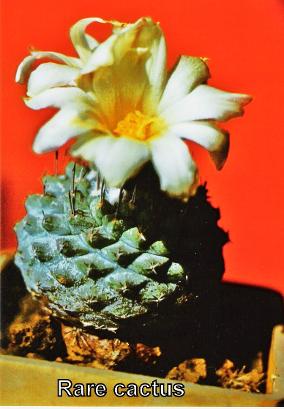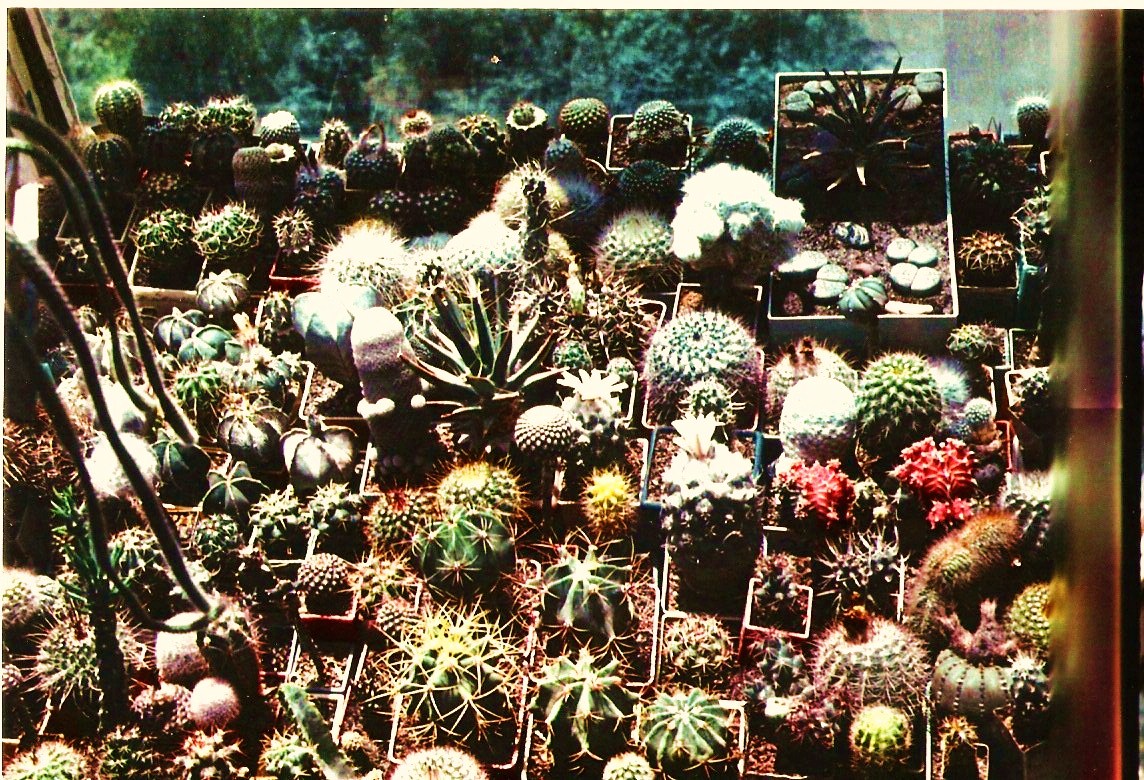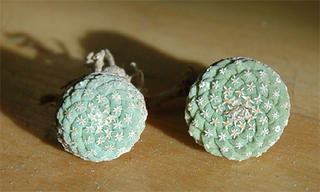
Strombocactus disciformis, Toumeya papiracantha are superb slow-growing miniature plants. It takes 8-10 years to begin blooming. Grafted on strong stock allow quickly reach the blooming age. I do domestic and International shipping for LOW PRICES. Strombocactus disciformis cactus for sale and Toumeya papiracantha for sale
I would like to introduce myself. I am an eager cactus fanatic. I begin my cactus collection in the earliest 70es latest century in Russia. In the end of 80es I had about 250 species of cacti in my collection. It contained cacti that I can find in Russia. Some rare cacti I had, for example, Strombocactus disciformis.

Strombocactus disciformis from my collection in Russia
Description: It is a rare geophytes, usually solitary.
Stem: The body is flattened or spherical, 3 to 8 cm high, reaching 20 cm in age, and 3 to 9 cm across. The crownis slightly depressed and felted. The colour is blue-green with greyish tinge, the base covered with brown corkyspots in age. It is composed of hard, spirally arranged rhomboid and imbricate tubercles, 1 to 1.8 cm high. These tubercules are flattened and almost truncated above and somewhat horny or keeled below.
Flowers: Arise on the crown, measure about 3.5 cm in length and breadth, are shiny cream coloured with occasional spots at the tip and in the throat, The filaments are white or reddish, the anthers yellow. The 8 to 10lobed stigma are white or yellowish.
Blossoming time: flowers emerge early in spring and are freely produced throughout the summer, remaining open for several days.
Many Cactus lovers do not know that buying young or grafted cacti, they made a good investment. After 3-4 years of growing the value of cacti increase twice.

My collection in Russia. I care it on the windowsill out of the room. It
had 8 hours of sunlight
In 2005 I moved to California US and began to collect rare cactuses. I tried to grow from seeds very rare and difficult to raise cactus species. Some of them were Strombocactus disciformis and Toumeya papiracantha. I choose this species for their unusual forms and almost impossibly to get them.
The genus Strombocactus have received a disproportionately high amount of attention by researchers. Whatever it is that attracts researchers to this group of plants is uncertain, but the result is usually the creation of many subspecies, varieties, and superfluous names. The genus Strombocactus, until recently consisted of a single species, but a new species has been created largely due to differences in seed structure.
Strombocactus disciformis is considered to be Vulnerable because of its limited range (extent of occurrence approximately 4,500 km2), it occurs in less than 10 locations, and is experiencing a decline in mature individuals due to illegal overcollection.

Strombocactus disciformis grows very slowly. On the picture are the Srombos approximately 1.5 cm (~0.6’’) in diameter and grow seven years from seed.
Cultivation: Although regarded as a choice and difficult plant in cultivation it is relatively very slow growing. It is often seen as a grafted plant but grows very well on its own roots too. Needs a very well drained mineral substratum with little organic matter (peat, humus). Requires strong sun to part sun to develop good compact growth and waterings should be rather infrequent, to keep the plant flat shaped and not become excessively elongated and unnatural in appearance. Use Water sparingly from March till October and keep perfectly dry in winter, or when night temperatures remain below 10° C (but some people give this plant a light monthly watering to prevent the drying and shedding of the lower tubercles.) It is hardy to -4°C (or less) for a short period. In the rest period no high atmospheric humidity!! Ensure a good ventilation.
Propagation: From woody stem cuttings Allow cut surface to callous over before planting From seed; direct sow after last frost
Seed Collecting: Allow unblemished fruit to ripen; clean and dry seeds. nblemished fruit must be significantly overripe before harvesting seed; clean and dry seeds.
Properly cleaned, seed can be successfully stored
Strombocactus disciformis
for sale Ǿ4 cm for $28.00.
The price is very low and you can buy it only from this page. This cactus is redy to bloom.
There is extremely low amount of plants
Scientific name: Toumeya papyrocantha Rare cactus
Etymology: The genus name "Toumeya" commemorates Dean James W. Toumey (New Mexico) who was also honoured by Britton & Rose, whose work benefited from Toumey’s fieldwork and collections of cactusspecimens. The species name "papyracantha" derives from the greek word “papyrus (παπυρος)” that means " papyrus (Cyperus papyrus); paper " and from “acantha (ακανϑα)” that means “thorn, spine" (The specific name implies: “papery spines”)
Origin: USA, Arizona (Southern portion of Navajo County, Apache County) New Mexico (southeast Rio Arriba County and McKinley County to Grant and Dona Ana counties) Texas (Hudspeth County) Colorado and Mexico. T. papyracantha is inconspicuous and probably irregular in occurrence; it may be more widespread than presently known.
Common name(s): Grama-grass cactus, Paper-spined cactus, Paperspine fishhook cactus, Toumeya  - Copy.jpg?timestamp=1451668937008)
Conservation status: Listed in CITES Appendix I
Quite abundant, at least in parts of range (6-20 occurrences globally reported), but now sharply reduced due to degradation of habitats, collectionand development. It is imperilled and vulnerable to extinction, But its highlyinconspicuous nature makes it a difficult species to locate and study.
Habitat: Grows in open flats in pinyon-juniperwoodlands,
great Plains grassland,
and Chihuahuan Desert grassland. At an elevation of
1500 - 2300 m. Restricted to fine, sandyclay
loams and red sandy soils; rarelygypseous;
often on highly erodable sites.
It is almost always found associated in
or near tufts or fairy rings of blue grama grass (Bouteloua gracilis)
where it is seldom seen thanks to its excellent camouflage because
the papery spines
resemble dried grassleaves. T.
papyracantha demonstrate the importance of microclimate variation
for cactus growth,
in fact this plant depends upon the favorable microclimate provided by grama
grass to survive. Stems usually shrink
during dry seasons,
leaving only the papery spines
visible above ground.
This population has very long flat papery spines. The centrals are brown with the new growth of a bright red color, the radials are short and pure white.
Description: Toumeya papyracantha is small cactus grows up to 8 centimeters tall by 2.5 wide. It is covered in so many spines they obscure the stems beneath. They are white, tan, or gray in color, papery in texture, Dark green, 2.5-20 cm tall and 1-2 cm in diameter. It has no ribs and tubercles are elongate.
Stem anatomy: The stele is particularly thin, usually 2 mm or less in diameter, without medullary vascular system. Large mucilage cells occur in the tubercles and in the cortex, but are not present in the pith. Tissues which have mucilage cells are conspicuously slimy when freshly cut. and sometimes twisted or wavy in shape.
Stems usually shrink during dry seasons, leaving only the papery spines visible above ground.
Cultivation: Needs moderate watering, because excess of water causes mature individuals to rot and die, especially after transplanting..Cultural Practices: Needs a very draining and mineral substratum
Toumeya papyracantha is a very rare cactus: 1. in the origin It is imperiled and vulnerable to extinction; 2. Seeds have very hard shells that why the germination is extreme difficulty. Germination can take several years; 3. Seedlings do not do well either, and some die each year, for this reason plants are commonly grafted on hardy stocks
Toumeya papyracantha for sale Ǿ1 cm for $4.79
 - Copy.jpg?timestamp=1451840654302)
Toumeya papyracantha is one of the rarest and most unusual species in the United States, the distribution is very limited. The species grows in Arizona, New Mexico and Texas, in Juniper-Pinyon forests, grassland
This population has very long flat papery spines. The centrals are brown with the new growth of a bright red color, the radials are short and pure white.
For this reasons I like the Toumeya papyracantha
Blossoming time: Blooming time: April/May
Propagation: Seeds: Temperature for optimum germination: night minimum approx 17 C day maximum, up to nearly 40 C, at any time of year with proper temperatures and day length (ca.13-14 hours); it is possible to extend day-length with artificial lights. Anyway the seeds germinate slowly with extreme difficulty and a low rate of success. scarification and stratification help, alternately freeze and thaw both wet and dry, but don’t keep wet, alternate wet and dry with changing temperatures. Germination can take several years, so keep pot and try again next year. Seedlings do not do well either, and some die each year, for this reason plants are commonly grafted on hardy stocks like Opuntia compressa. In this case they are easy to grow and no special skill is required.
 Translate
Translate